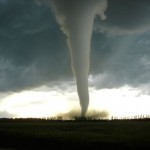The real story of 2012 is one of unextreme weather and natural events. Deaths globally in 2012 from natural disasters were 90% below the longterm average.
The online, eco-leftist TAZ from Berlin has an article about reinsurer Munich Re’s Natural Catastrophe Statistics 2012 report on weather and natural disasters, released yesterday. 2012 was a year of few deaths and relatively little damage from natural disasters worldwide.
Read the rest at No Tricks Zone


Is drought taken into account? Doubtful.
At the top of the page you will see that it is from Germany. ‘Munich Re’ is a German company, and based there. Germany is not exactly known for its devastating droughts. I’m not claiming that droughts could never occur, but that, for a company such as ‘Munich Re’, there are disasters that are far more likely to occur (like floods), so this omission is not exactly a cardinal sin.
Just an FYI, Munich Re is one of the world’s largest reinsurers. They do business internationally, so I’m shure that they are talking about all types of “natural catastophes” including drought.
What I meant was that being a German company, based in Germany, their priorities would reflect those facts accordingly, even though they now have an international presence.
I wasn’t disputing that, I was just pointing out that the report was for the whole planet, not just Germany.
‘Yet, always itching to jack up their premiums, Munich Re insists that climate change is a major crisis for humanity, and although Hurricane Sandy cannot be attributed to man, it is “a sign of what the future holds”‘.
If ‘Hurricane Sandy cannot be attributed to man’, why do they a) even mention it, and b) conclude, from the hurricane, that it is ‘a sign of what the future holds’ when there is, by their own admission, no established connection between the two? This story, to my knowledge, was not even hinted at in the Australian media. This truly is disgraceful.
Could it be they recognize climate change but refuse the AGW aspect? Seems the logical conclusion to me. Still no confirmation re: drought being included in their evaluations.
Actually a good point. But, the point of posting this story was not to confirm or dispute whether or not they recognise climate change, or if they included the effects of drought or not. But, like I usually do, I looked it up and found that my assumption was incorrect. It seems that most of the damage from drought, in the US anyway, was covered by another company.
http://www.insurancejournal.com/news/international/2013/01/03/275865.htm
“Nearly half of the USA’s arable acreage was hit by the 2012 event. The overall agricultural crop losses in the USA in 2012 totaled around $20 billion, of which approximately $15–17 billion is covered by the public-private multi-peril crop insurance program, making it the biggest loss in US agricultural insurance history. In average years, insured losses are around $9 billion.”-”
The point of posting this story was to show that averages worlwide are lower. Deaths and damage were lower worldwide. This I think is significant when we just had a few months ago many people in the media talking about how bad a year it was with extreme weather events. But it turns out that almost half of all the damage caused to the entire planet was Hurricane Sandy. It has also been a claim of warmists that increased extreme weather events were evidence of AGW. And this refutes that claim. Not to mention that nobody is talking about how cold it is in Russia, and Alaska again this year.
Thanks for the civilized and reasoned response. The article mentions reduced deaths as its highlight which while a good thing is pretty meaningless in and of itself. The cost of drought for the 2012 is appreciated and noted to be much higher than normal as I suspected. Also, the fact that one or two storms, not many, accrued most of the damage/costs also doesn’t strengthen its argument. You could actually point to the fact that these fewer storms are bigger and more damaging than normal, which is part of the climate change predictions. I’m just pointing out the opposite side of the coin.
Hurricane Sandy’s storm surge was likely surpassed in the New England hurricanes of 1635 and 1638. From 1635 through 1954, New England was hit by at least five hurricanes producing greater than 3 m storm surges in New England. Analysis of sediment cores led to the conclusion “that at least seven hurricanes of intensity sufficient to produce storm surge capable of overtopping the barrier beach (>3 m) at Succotash Marsh have made landfall in southern New England in the past 700 yr.” All seven of those storms occurred prior to 1960.